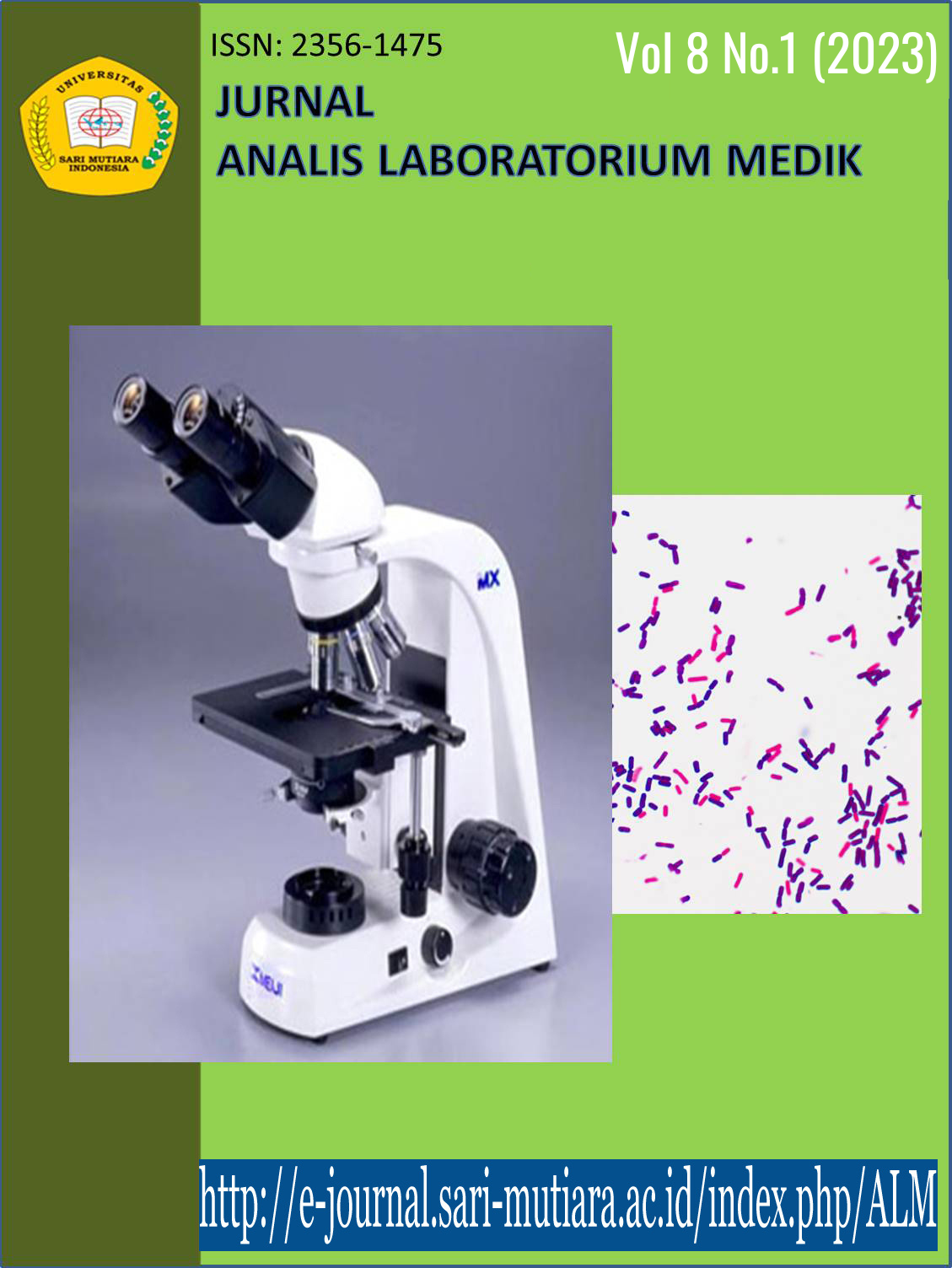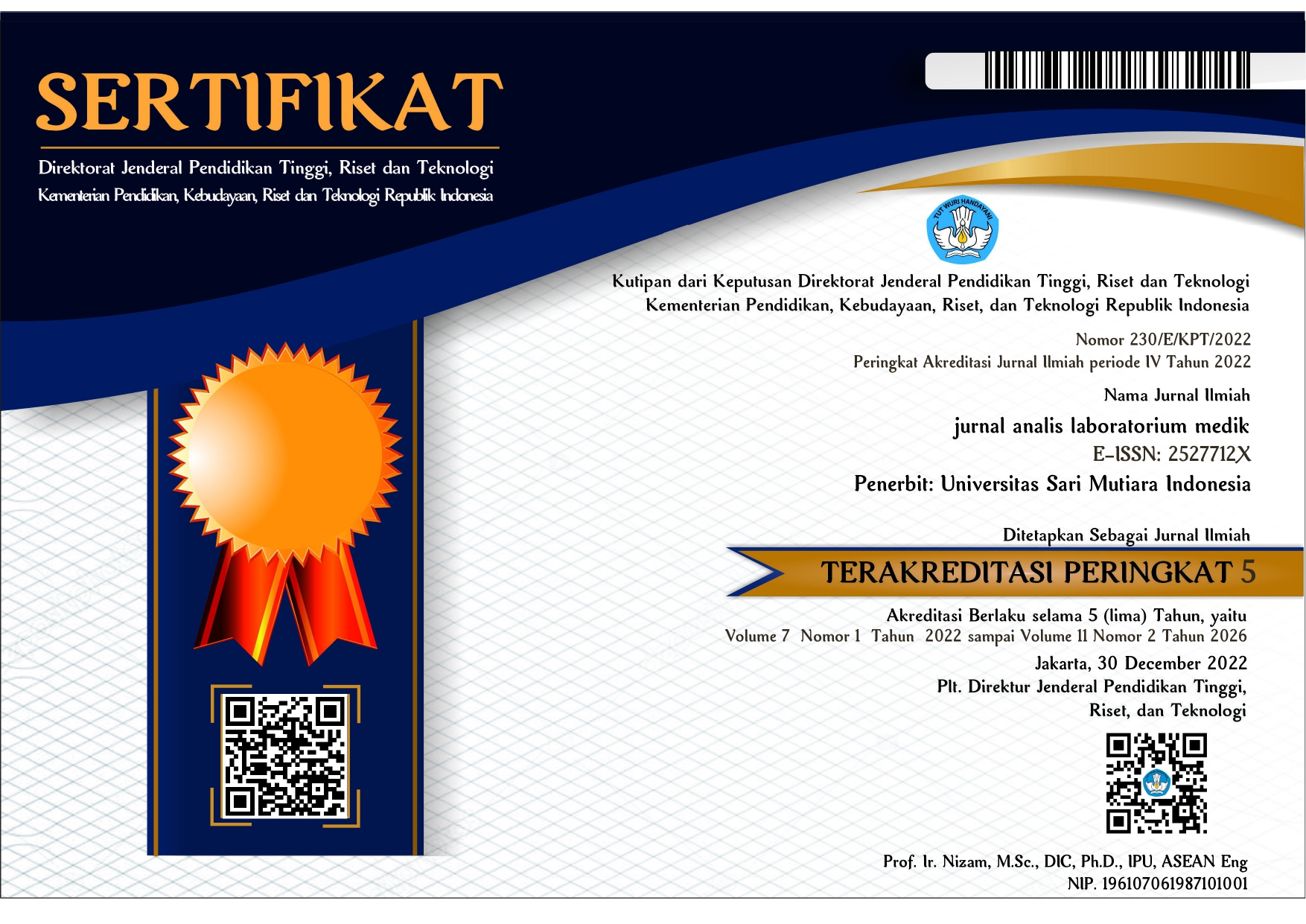DESAIN PRIMER SECARA IN SILICO UNTUK AMPLIFIKASI GEN tcdA BAKTERI CLOSTRIDIUM DEFFILCILE
DOI:
https://doi.org/10.51544/jalm.v8i1.3806Keywords:
in silico, primer, Clostridium difficile, tcdAAbstract
Antibiotics are drugs used to fight infections caused by bacteria. C. difficile bacteria is a bacterium that causes Clostridium difficile infection (ICD). Toxin A of C. difficile bacteria is exotoxin A (tcdA) which is a virulence factor that causes disease. Toxin A can damage the intestinal mucosa and cause bleeding. The cost of examining and treating patients with AAD and PMC is very high, so the dosage must be determined correctly. Laboratory tests function to determine the presence or absence of an ICD. The discovery of specific biomarkers is a discovery priority to improve the quality of laboratory tests. Specific primary design is an important step in all types of laboratory examination methods, one of which is molecular examination by PCR. The primary design must have specific properties so as to be efficient at target amplification. This study aims to obtain a primer design that can be used to limit the amplification area of the TcdA gene in silico. This study used a literature study from the NCBI genbank to obtain the tcdA gene sequence of C. defficile bacteria with accession number DQ902560.1. The tcdA gene sequence of C. difficile bacteria was analyzed using Primer3Plus to determine whether there is hairpin and dimer formation. Furthermore, identification was carried out using web-based in silico PCR to determine the number of amplicon and visualization on the electrophoretic gel. The level of tcdA gene homology in the species group in the BLAST test. The results showed that the best primer design for in silico detection of the tcdA gene of C. difficile was the forward primer 5'-GCAGATGCCAAGAGACACAC-3' and the reverse primer 3'-GCAGATGCCAAGACACACAC-5'. The primary design is able to amplify the tcdA gene region with a size of 247 amplicons.
Downloads
References
Bikandi, J., Millán, R. S., Rementeria, A., & Garaizar, J. (2004). In silico analysis of complete bacterial genomes: PCR, AFLP-PCR and endonuclease restriction. Bioinformatics, 20(5), 798–799. https://doi.org/10.1093/bioinformatics/btg491
Debie Rizqoh, Nita RatnaSari, Rina Nurlia Wati, Fery Santosa, & Rianita Hasanah. (2016). Aktivitas Bakteri Filosfer Daun Reundeu (Staurogyne longata) Sebagai Penghasil Senyawa Antimikrob Potensial. Jurnal Analis Laboratorium Medik, 1(1), 1–7.
Ethica, S. N., Sulistyaningtyas, A. R., & Darmawati, S. (2019). In-silico specificity comparison between GMF-GMR and JMF-JMR primers for detecting moaC genes of food spoilage bacteria pseudomonas spp. IOP Conference Series: Earth and Environmental Science, 292(1). https://doi.org/10.1088/1755-1315/292/1/012033
Huang, J. H., Shen, Z. Q., Lien, S. P., Hsiao, K. N., Leng, C. H., Chen, C. C., Siu, L. K., Chong, P. C. S., & Vedantam, G. (2015). Biochemical and immunological characterization of truncated fragments of the receptor-binding domains of C. difficile Toxin A. PLoS ONE, 10(8), 1–27. https://doi.org/10.1371/journal.pone.0135045
Kalendar, R., Lee, D., & Schulman, A. H. (2011). Java web tools for PCR, in silico PCR, and oligonucleotide assembly and analysis. Genomics, 98(2), 137–144. https://doi.org/10.1016/j.ygeno.2011.04.009
Kumala, W. (2004). Clostridium Difficile: Penyebab Diare dan Kolitis Pseudomembranosa, Akibat Konsumsi Antibiotika yang Irasional. Jurnal Kedokteran Trisakti, 23(1), 34–38.
Lagier, J. C., Edouard, S., Pagnier, I., Mediannikov, O., Drancourt, M., & Raoult, D. (2015). Current and past strategies for bacterial culture in clinical microbiology. Clinical Microbiology Reviews, 28(1), 208–236. https://doi.org/10.1128/CMR.00110-14
Lall, S., Nataraj, G., & Mehta, P. (2017). Use of culture- and ELISA-based toxin assay for detecting Clostridium difficile, a neglected pathogen: A single-center study from a tertiary care setting. Journal of Laboratory Physicians, 9(04), 254–259. https://doi.org/10.4103/jlp.jlp_157_16
Liwang, F., & Sinto, R. (2021). Pendekatan Klinis Terkini Infeksi Clostridium difficile Nosokomial. Jurnal Penyakit Dalam Indonesia, 8(2), 104. https://doi.org/10.7454/jpdi.v8i2.307
Marra, F., George, D., Chong, M., Sutherland, S., & Patrick, D. M. (2016). Antibiotic prescribing by dentists has increased Why? Journal of the American Dental Association, 147(5), 320–327. https://doi.org/10.1016/j.adaj.2015.12.014
McDonald, L. C., Gerding, D. N., Johnson, S., Bakken, J. S., Carroll, K. C., Coffin, S. E., Dubberke, E. R., Garey, K. W., Gould, C. V., Kelly, C., Loo, V., Shaklee Sammons, J., Sandora, T. J., & Wilcox, M. H. (2018). Clinical Practice Guidelines for Clostridium difficile Infection in Adults and Children: 2017 Update by the Infectious Diseases Society of America (IDSA) and Society for Healthcare Epidemiology of America (SHEA). Clinical Infectious Diseases, 66(7), e1–e48. https://doi.org/10.1093/cid/cix1085
Purba, D., & Manurung, D. B. S. (2016). Perbandingan Pemeriksaan Basil Tahan Asam Metodedirect Smear Dan Metode Imunochromatographi Test Pada Tersangka Penderita Tuberkulosis Paru Di Upt. Kesehatan Paru Masyarakat Dinas Kesehatan Provinsi Sumatera Utara. Jurnal Analis Laboratorium Medik, 1(1), 32–37.
Purba, D., & Manurung, D. B. S. (2017). Perbandingan Pemeriksaan Basil Tahan Asam Metodedirect Smear Dan Metode Imunochromatographi Test Pada Tersangka Penderita Tuberkulosis Paru Di Upt. Kesehatan Paru Masyarakat Dinas Kesehatan Provinsi Sumatera Utara. IEEE International Conference on Acoustics, Speech, and Signal Processing (ICASSP) 2017, 41(2), 84–93.
Putri, D. I. (2015). Infeksi Clostridium Difficile Pada Diare yang Diinduksi Penggunaan Antibiotika Clostridium Difficile Infection On Antibiotic Associated Diarrhea. Majority, 4(7), 39–44.
Raso, R., & Alessandro, B. (2014). Quantitative Real-Time PCR - Methods and Protocols | Springer.
Riley, M. C., Aubrey, W., Young, M., & Clare, A. (2013). PD5: A general purpose library for primer design software. PLoS ONE, 8(11). https://doi.org/10.1371/journal.pone.0080156
San Millán, R. M., Martínez-Ballesteros, I., Rementeria, A., Garaizar, J., & Bikandi, J. (2013). Online exercise for the design and simulation of PCR and PCR-RFLP experiments. BMC Research Notes, 6(1), 2–5. https://doi.org/10.1186/1756-0500-6-513
Ye, J., Coulouris, G., Zaretskaya, I., Cutcutache, I., Rozen, S., & Madden, T. L. (2012). Primer-BLAST: a tool to design target-specific primers for polymerase chain reaction. BMC Bioinformatics, 13, 134. https://doi.org/10.1186/1471-2105-13-134
Downloads
Published
How to Cite
Issue
Section
License
Copyright (c) 2023 I Gusti Agung Ayu Satwikha Dewi , Amellya Octifani

This work is licensed under a Creative Commons Attribution-ShareAlike 4.0 International License.
Syarat yang harus dipenuhi oleh Penulis sebagai berikut:
Â
- Penulis menyimpan hak cipta dan memberikan jurnal hak penerbitan pertama naskah secara simultan dengan lisensi di bawah Creative Commons Attribution License yang mengizinkan orang lain untuk berbagi pekerjaan dengan sebuah pernyataan kepenulisan pekerjaan dan penerbitan awal di jurnal ini.
- Penulis bisa memasukkan ke dalam penyusunan kontraktual tambahan terpisah untuk distribusi non ekslusif versi kaya terbitan jurnal (contoh: mempostingnya ke repositori institusional atau menerbitkannya dalam sebuah buku), dengan pengakuan penerbitan awalnya di jurnal ini.
- Penulis diizinkan dan didorong untuk mem-posting karya mereka online (contoh: di repositori institusional atau di website mereka) sebelum dan selama proses penyerahan, karena dapat mengarahkan ke pertukaran produktif, seperti halnya sitiran yang lebih awal dan lebih hebat dari karya yang diterbitkan. (Lihat Efek Akses Terbuka).










